Revolution in Hong Kong
What the Media Doesn't Report:
(photo: Reuters/Aflo)
Hong Kong protests — no, it’s a Hong Kong revolution.
Beginning with the protests about the controversial extradition bill, at times over two million people, or one-fourth of the population, participated in these protests.
The momentum has not slowed down despite the withdrawal of the extradition bill;
mixed opinions of support and criticism toward “rioters” are voiced around the world.
What exactly is going on?
And what can Japan do about it?
Citizens hold each other’s hands to show solidarity and determination toward the protest, forming a “human chain.”
Field Report Part 1
“People of Japan, please help us.”
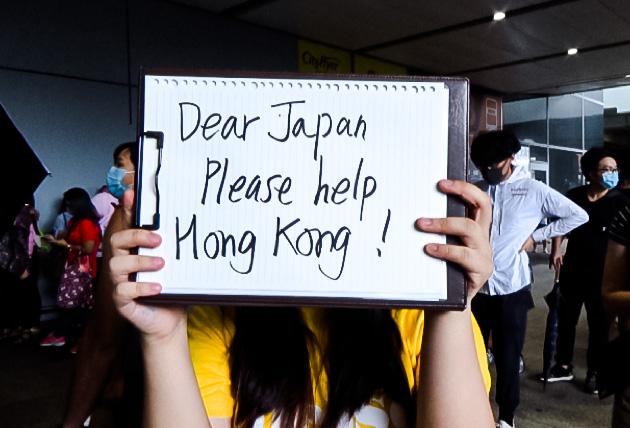
Clashes between an army of protesters and policemen; tear gas fired everywhere.
TV news channels don’t tell the whole story.
We wandered around the humid city of Hong Kong to understand the true emotions of their people.
(Editorial Department Kotaro Baba)
“Is this North Korea…?” I couldn’t help but mutter to myself.
I casually asked a few participants in the protest for an interview. The interview was held in a hotel room where no one could see. Most of them, however, weren’t willing to appear on film or even be recorded on a voice recorder.
“A few years ago, we didn’t have to hide our faces,” said a female participant in her 20s who wished to stay anonymous.
Recent chips found in the city’s surveillance cameras that allow data to be sent to mainland China, and policemen that dress as reporters to film protesters’ faces, have made people uneasy and fearful.
“It’s just a matter of when they’ll conduct [mass arrests],” she said. “The preparation has already been made. Recently, everyone has been extraordinarily scared.”
An army of protesters that fills the streets seems high-spirited at first glance. But when we ignorantly pointed our cameras at them, the protesters suddenly put their heads down. A passerby scolded us: “They’ll get scared. Stop!” To drink water, those protesters even pinched their masks to create a small opening and stuck their water bottles in the opening to keep their identity concealed.
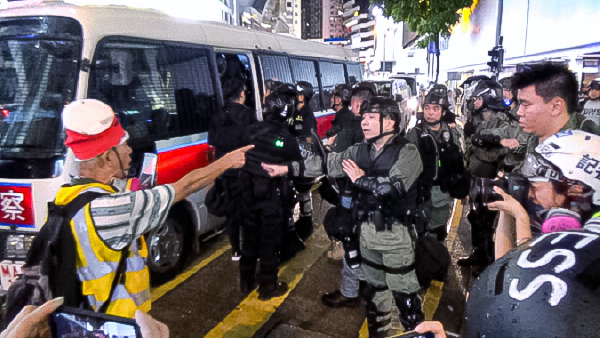
A “Cry,” Not a “Riot”
The protest amplified as the sky became darker and darker. As I followed the protesters, special police units appeared in front of my eyes. They stormed into the crowd of protesters while yelling and were holding batons, shields and guns (most likely tear gas or rubber bullets).
The Hong Kong police have deployed water cannon trucks and fired artificially-colored water in the streets, leaving the ground lightly dyed blue. Special units that finished “cleaning,” held a young man and a woman by their arms and dragged them into the patrol wagon covered with wire mesh.
During my stay, I saw on news that citizens were indiscriminately attacked by the police in a subway station. I passed by the same station the following day. The moment the train door was about to open, I thought, ‘What if policemen flow into the train? Will I be able to fight off their batons with my tripod?”
“You can no longer express what you want to express. This isn’t the Hong Kong we know…,” the female protester said.
I didn’t know what to say.
China isn’t simply attempting to take over Hong Kong; the process has already begun. Young protesters are experiencing the terror of a “police nation.” And yet, they hesitate, fear and resist desperately. After watching them, I couldn’t tell them to “stop being violent and protest peacefully to gain support from the international community.”
During the protest, the rallying cry “Fight for Freedom!” was heard all around. The “freedom” they screamed was no longer a chant — it was a “cry,” an earnest, heavy cry. Even after I returned to my silent hotel room, their cries still echoed in my ears.
Do It for Everyone, Even If Scared
“How can people participate amidst these fears?” I asked.
“People are doing it for everyone else, rather than for themselves. It doesn’t matter if we’re scared. We don’t want to hand over this kind of society to younger generations,” the female participant answered.
She raised her voice regarding the protests being reported as “riots.”
“I mean, since you’re covering the protests, you understand that there exists love, right!?”
She was right.
I covered a meeting organized by secondary school protesters. A young boy carrying a McDonald’s bag filled with a full meal passed between gaps of participants and asked if someone needs food. He must have placed the order for anyone who was hungry.
The reporter/I was interviewing people without understanding how dangerous it was on the field. Someone placed a yellow helmet on the reporter’s/my hands and disappeared.
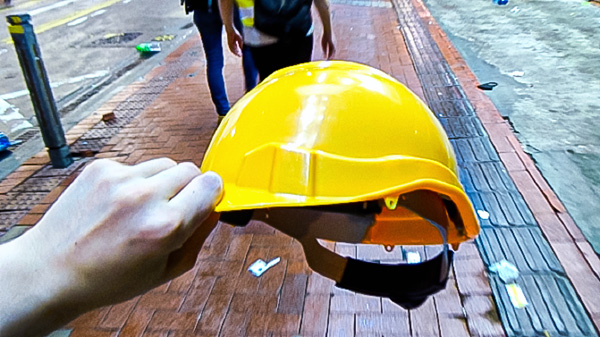
Seniors and volunteer groups that wore bibs with “守護孩子 (Protect children)” written on them appeared. At night when young protesters were being taken away by the police, one of the seniors let out a loud cry and began opposing. He stepped in amongst the policemen and was dragged out. Another elderly man got so heated during the protest that he passed out.
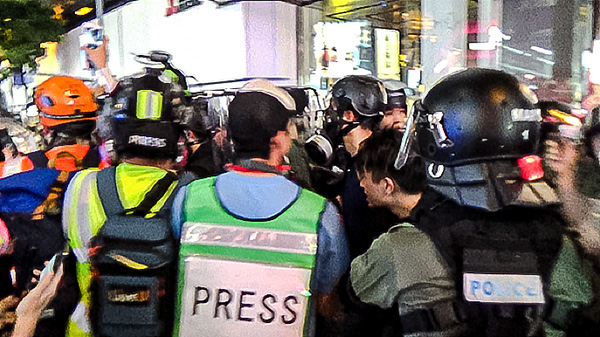
The media often portrays scenes of violent protesters, but something surprisingly “warm” was flowing within them.
The fact that there’s a high chance of arrest and police brutality is no doubt scary; but protesters still stand up for each other and fight on with the support they receive from others.
Is Japan a Bystander or Perpetrator?
Something shocking happened.
This incident occurred while the reporter/I was covering the secondary students’ meeting. When the reporter/I mentioned that Japanese people are actually uninterested in Hong Kong’s situation, it wasn’t just one or two children who said, “I know.”
Behind us, news reporters from Japan’s TV stations stood in front of cameras and gave a loud “commentary”: “These students are boycotting classes…”
When asked what actions Japan can take, a participant who wished to stay anonymous answered.
“I want them to stop misreporting at the very least.”
These protesters knew that some in the Japanese media take the Hong Kong authorities’ words and report that Hong Kong people are “rioters.” Unfortunately, today’s Japan is a bystander at best, a perpetrator at worst.
However, there were still voices of hope toward Japan.
While reporting, a local female college student asked, “Are you Japanese?” She had made flyers written in Japanese and asked me to share them. There were various types of flyers made creatively. I could imagine her sitting in front of the designing software on her laptop, working hard to make the flyers.
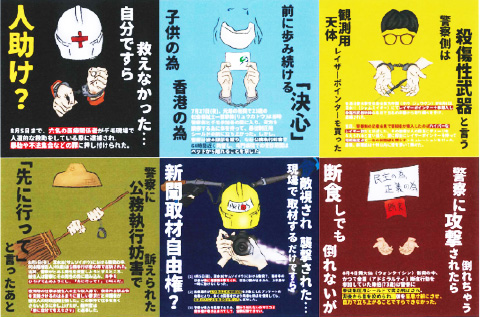

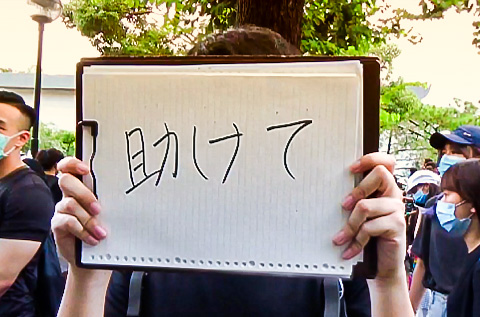
Expectations for Japan And Frustrations
Ryuho Okawa, Founder and CEO of Happy Science, conducted spiritual readings of China’s Chairman Xi Jinping and Hong Kong’s democracy activist Agnes Chow. The purpose of a spiritual reading is to dig into the subject’s subconscious. The guardian spirit of Xi Jinping revealed that he is considering the possibility of sending the People’s Liberation Army to Hong Kong for oppressive purposes.
“Japan should step over our corpses, change their national policy and declare what is right,” the guardian spirit of Chow said, responding to the crisis. “…If possible, I would like them to send self-defense forces… Please send self-defense forces in the name of protecting Japanese people abroad. Then, the U.S. will take action.”
To the journalist who reported from abroad, these words highlighted the Hong Kong peoples’ frustrations and their slight hope for help from “Asia’s great country, Japan.”



















